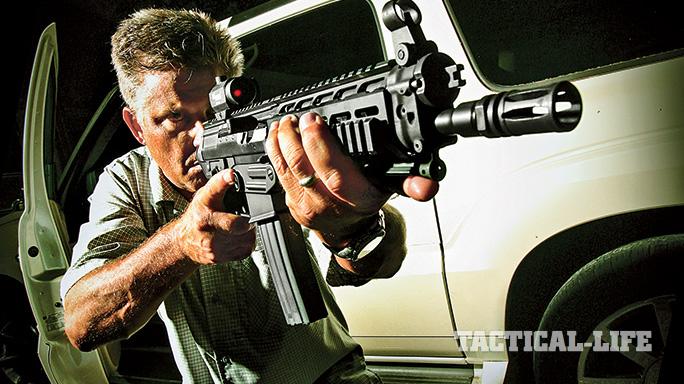Pat McNamara’s priorities for setting up a vehicle are not overly sexy. What’s most important? Gas in the tank. “My rule is the vehicle never sits in the driveway with less than 3/4 of a tank.” A vehicle has to perform reliably for a predictable amount of time to be a dependable part of a plan, so McNamara starts there.
MAINTENANCE
You don’t have to be a mechanic to cover the basics of vehicle maintenance. Start from the ground and work your way up. As the four tires are the vehicle’s interface with the terrain over which you travel, they and anything that controls or stabilizes them are critical. Brakes should be checked at least at every oil change and serviced if excessive noise or vibration occurs during braking. Don’t forget the shocks and suspension. Though most modern shocks are sealed, the suspension needs lubrication (typically grease) and inspection. You don’t know the value of good shocks until you replace a worn set and feel how much you were missing in control and stability.
Advertisement — Continue Reading Below
- RELATED: Sentinel Security: Training with Pat McNamara
- RELATED: Car Self-Defense: Tips to Prevent, Deter & Overcome
Some parts of a vehicle, like brake pads, were made to wear and be replaced. Belts and hoses are primary among them. A broken belt or ruptured hose can bring an otherwise functional vehicle to a stop in seconds. Take a few seconds at every other fill up, or at least every oil change, to visually inspect them closely for age and wear. The same goes for fluids. This includes brake fluid, transmission fluid, engine oil and coolant. Learn to check your own levels even if you don’t know how or don’t have the time to change or add the fluid yourself. You should at least be able to give precise instructions to a mechanic and ask informed questions.
APPEARANCE & LOADOUT
There are few things more symbolic in America than the choice of one’s vehicle. The options are broad and modifications are limitless. But from a personal safety standpoint, less is more. “My day to day vehicle is a Honda Civic so it’s pretty benign. No gun stickers of any kind. Clean inside. No stereo system worth stealing,” noted McNamara.
Advertisement — Continue Reading Below
So what do you carry? For McNamara, it’s the basics. “I’ve got an AR in the trunk with a Leupold one-power site with crosshairs so I don’t have to worry about the battery. It’s locked but not loaded. I’ve got a battle bag with it. Eight mags loaded, eyes, ears, water and oil.”
DRIVING HABITS & AWARENESS
Being aware of one’s surroundings with a mind for an egress (escape) route applies equally to the road as much as foot travel. Keeping a car-length interval between your vehicle and the one in front of you is not just more safe, it provides room to maneuver and time to react. But these are all techniques that start with awareness.
Advertisement — Continue Reading Below
McNamara notes: “Take a look around and into the depths. It only takes a second to scan your ‘primary and secondary’ sectors. Your primary sector is directly outside of your vehicle and your secondary sector runs two or three cars deep in all directions. You will see things you have never seen before.”
And one final Sentinel tip: “Get into the habit of backing into a space instead of pulling into it. Not only does this allow for easier departure, but it may mitigate any would-be scammers looking for you to back into them. Make it a routine to hook your keys on a belt loop or clip them onto your purse so they are at the ready. Buy one of those promotional key clips with a built-in light
so that you have an emergency light at your disposal at all times.”
To learn more about Pat McNamara and his training, visit tmacsinc.com.
Advertisement — Continue Reading Below
This article is from the spring 2015 issue of Personal & Home Defense. To read more and subscribe, please visit PersonalDefenseWorld.com.
























